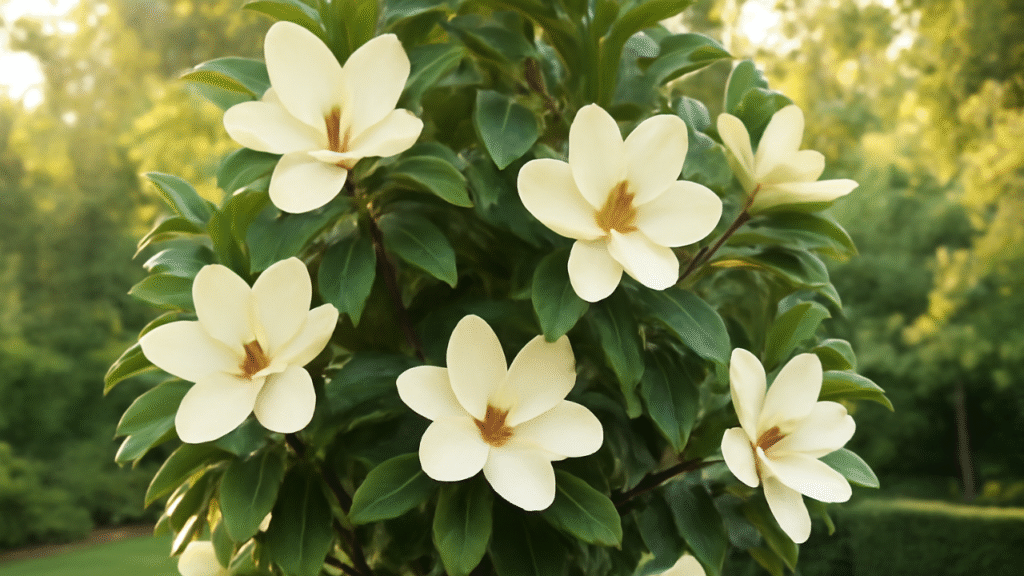
Table of Contents
ToggleHow to Grow and Care for a Teddy Bear Magnolia Tree: Expert Tips for Beautiful Blooms and Healthy Growth
Imagine stepping into your garden and being greeted by the soft, velvety petals of a teddy bear magnolia tree in full bloom. Its creamy-white flowers, paired with glossy green leaves, create an elegant touch that transforms any landscape into a stunning paradise. But here’s the catch: many gardeners struggle with growing this beauty. 🌸
If you’ve ever wondered why your magnolia tree isn’t thriving or how to get it to bloom beautifully year after year, you’re not alone. Whether you’re a beginner gardener or an experienced plant enthusiast, getting your teddy bear magnolia tree to reach its full potential can be a challenge. The right care, the proper planting techniques, and consistent maintenance are crucial to unlocking its vibrant beauty.
In this guide, we’ll walk you through expert tips and practical advice on how to grow and care for your teddy bear magnolia tree, ensuring you enjoy its gorgeous blooms and healthy growth for years to come. Ready to transform your garden? Let’s dive in! 🌿
🌼🐻 What is a Teddy Bear Magnolia Tree? 🐻🌼
If you’re looking for a beautiful, compact tree that adds charm to your garden, the teddy bear magnolia tree might be the perfect choice! Known for its soft, velvety flowers and glossy leaves, this tree is a true showstopper. But what exactly makes it so special? 😊🌟
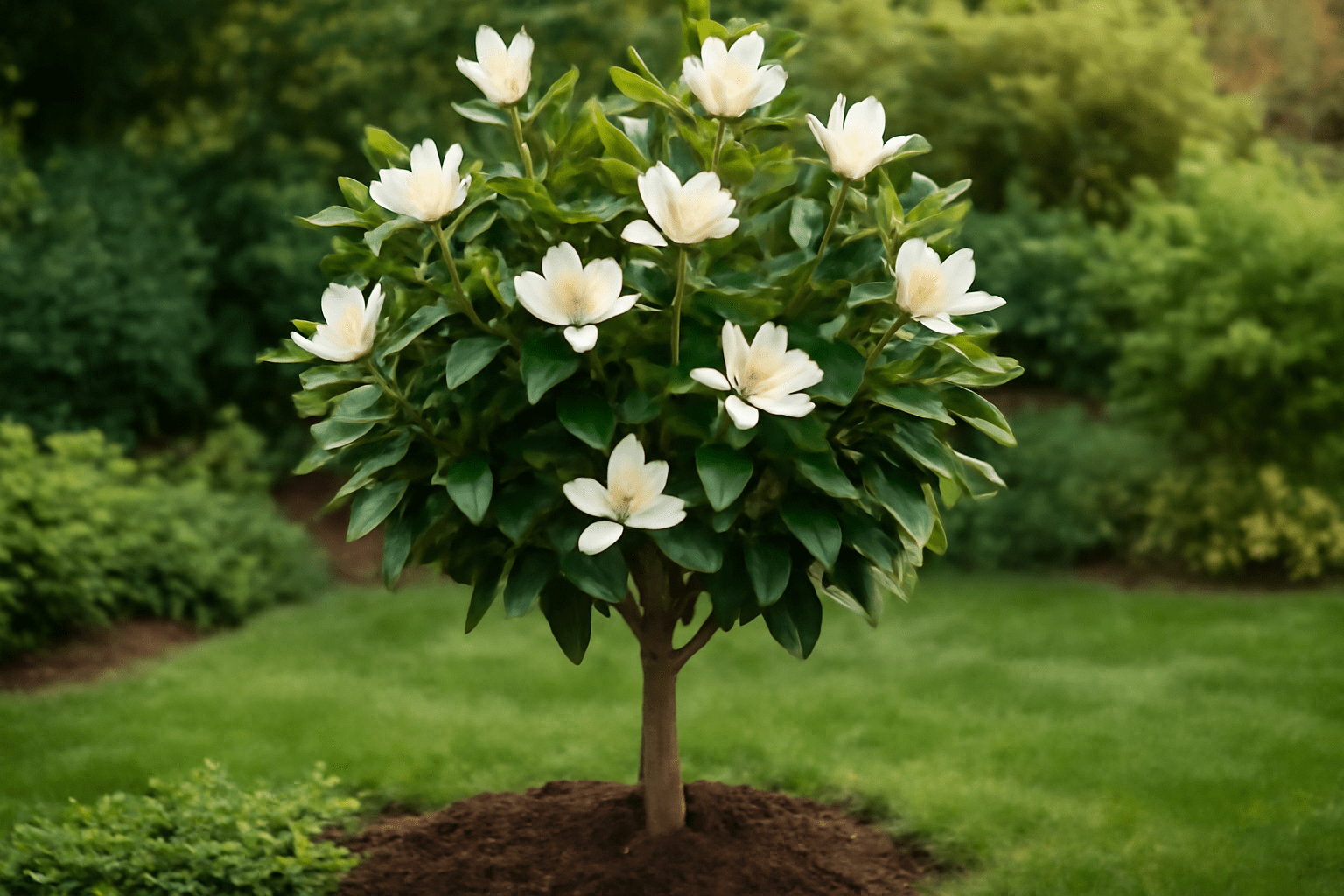
🌿 A Quick Overview 🌿
The teddy bear magnolia tree (Magnolia grandiflora ‘Little Gem’) is a smaller variety of the Southern Magnolia, developed for smaller spaces while still showcasing the classic beauty of larger magnolias. It’s a hybrid that maintains all the elegance of its larger cousins but in a more manageable size. 🌸🌱
🌸 Key Features of the Teddy Bear Magnolia Tree 🌸
🌱 Height 🌱:
Unlike the towering Southern Magnolias, this tree typically grows to about 10–15 feet tall, making it perfect for smaller gardens or even as a container plant. 🏡🌳
🌷 Flowers 🌷:
The teddy bear magnolia tree blooms in early spring, producing large, creamy-white flowers that resemble soft, teddy bear fur. 🌷✨ These blooms are sure to capture attention with their velvety petals and delightful fragrance! 🌸🌿
🍃 Leaves 🍃:
It has dark, glossy green leaves that stay lush and attractive all year long, providing a great backdrop to the stunning blooms. 🌿🍃 These leaves provide a perfect contrast to the bright flowers and keep your garden vibrant year-round! 🌞
🌍 Hardiness Zone 🌍:
This tree thrives in USDA Zones 5-9, making it suitable for a variety of climates across the country. 🌎🌤️ No matter where you live, this tree can adapt and thrive, bringing beauty and joy to your outdoor space! 🌳💚
🌞 Why Choose a Teddy Bear Magnolia Tree? 🌞
Whether you’re a beginner or a seasoned gardener, the teddy bear magnolia tree offers the perfect blend of beauty, compact size, and ease of care. Its fragrant, showy blooms and attractive foliage make it an excellent choice for those who want a dramatic garden centerpiece without worrying about space limitations. 🌸🌟
Ready to grow one of these charming trees in your own backyard? Keep reading to learn how to nurture it into a stunning beauty! 🌿💚
🌞🌱 Ideal Growing Conditions for a Teddy Bear Magnolia Tree 🌱🌞
A teddy bear magnolia tree is truly a showstopper in your garden, but to ensure it thrives, you need to provide the right growing conditions. Let’s dive into the essential factors that will help your magnolia tree flourish! 🌸✨
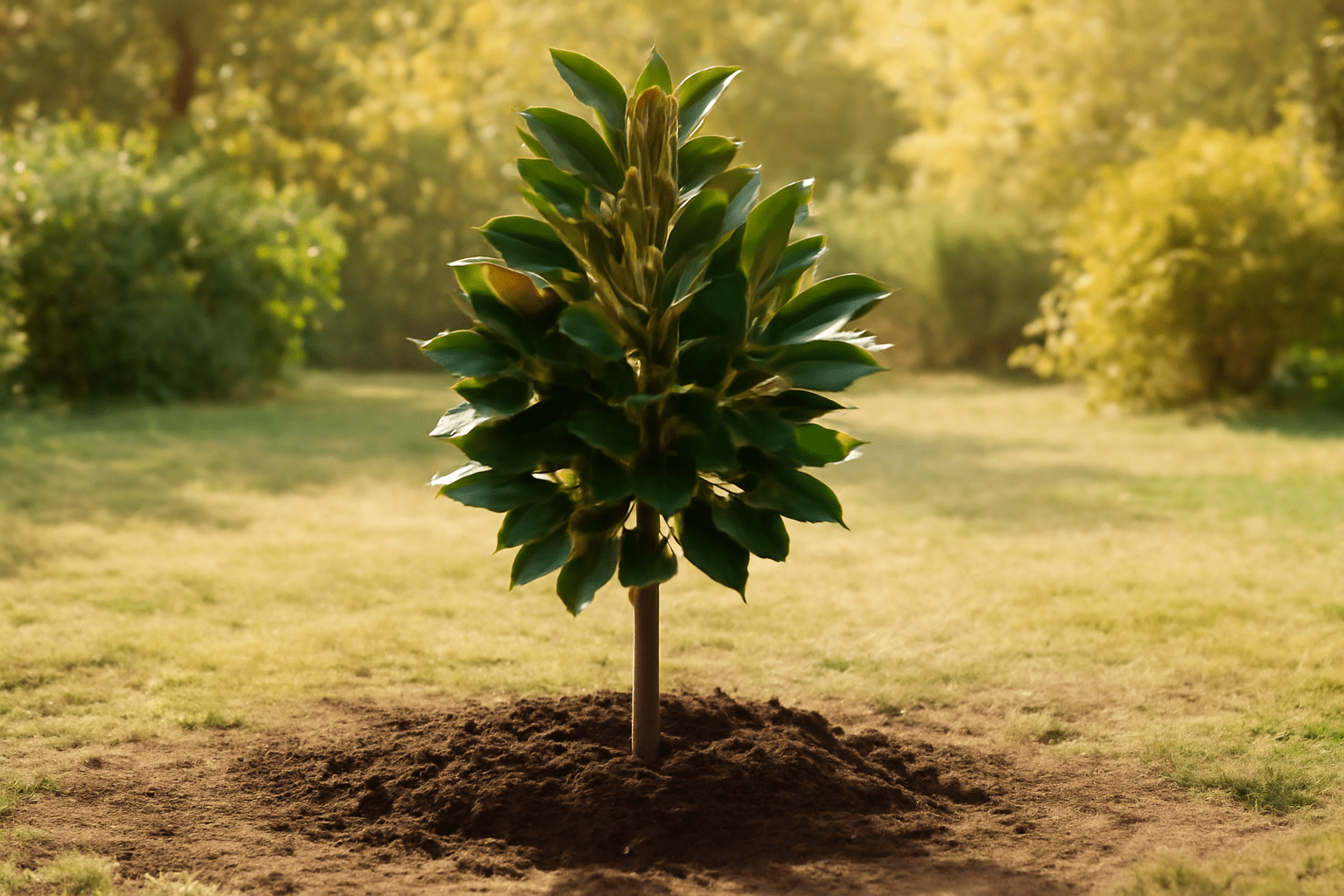
1. 🌞 Sunlight: Let the Sunshine In! 🌞
Your teddy bear magnolia tree loves sunlight! It thrives in full sun, meaning it should get at least 6 hours of direct sunlight per day. ☀️ This exposure helps it produce those stunning blooms and maintain its healthy growth. However, it can also tolerate some light shade, especially in hotter climates. 🌞🌳 So, pick a spot in your garden where the sun shines through for most of the day—ideally near a southern or western-facing area. 🌅
2. 🌿 Soil: Get It Just Right! 🌿
Magnolias prefer well-draining, slightly acidic soil with a pH of 5.5 to 6.5. 🌱 If the soil is too alkaline or too heavy (like clay), your tree might struggle to grow properly. To improve drainage and create the perfect soil environment:
- Mix in organic compost or peat moss before planting. 🍂
- Avoid overly compacted soil—loosen it up a bit to allow roots to breathe. 🌿
- Consider using a soil test kit to check the pH, especially if you’re unsure about your garden’s soil composition. 🔬
3. 💧 Watering: Keep It Moist, But Not Soaked 💧
Magnolia trees are not fond of dry conditions, but they don’t like “wet feet” either! 💦 The key is to keep the soil evenly moist. Here’s how to do it:
- Water deeply, but less frequently, to encourage deep root growth. 🌱
- Ensure good drainage so water doesn’t pool around the roots, as this can lead to root rot. 🚫
- In hot, dry weather, you may need to water more often, but always check the soil’s moisture level first. 🌞💧
4. 🌳 Space: Give It Room to Grow 🌳
Although the teddy bear magnolia tree is a compact variety, it still needs some space to spread out. 🌳 It typically grows 10-15 feet tall and wide. Be sure to plant it:
- At least 8-10 feet away from buildings, fences, and other trees. 🏡
- In an open area where it has plenty of space to grow without competition for nutrients. 🌿
5. 🌡️ Temperature: A Tree for Moderate Climates 🌡️
This magnolia variety is hardy in USDA Zones 5 to 9. 🌍 It can handle some cold, but extreme temperatures below -10°F (-23°C) may harm it. If you live in a region with harsh winters, consider planting your magnolia in a sheltered spot or providing winter protection. ❄️🛡️
By providing the right sunlight, soil, watering, and space, you’ll create the perfect environment for your teddy bear magnolia tree to thrive and produce those incredible blooms year after year. 🌸🌿
🌱🌸 Planting Your Teddy Bear Magnolia Tree 🌸🌱
Planting a teddy bear magnolia tree correctly is key to ensuring its long-term health and vibrant blooms. 🌷 With the right steps, you’ll set your tree up for success from the very start. Let’s walk through the planting process in simple, easy-to-follow steps! 😊
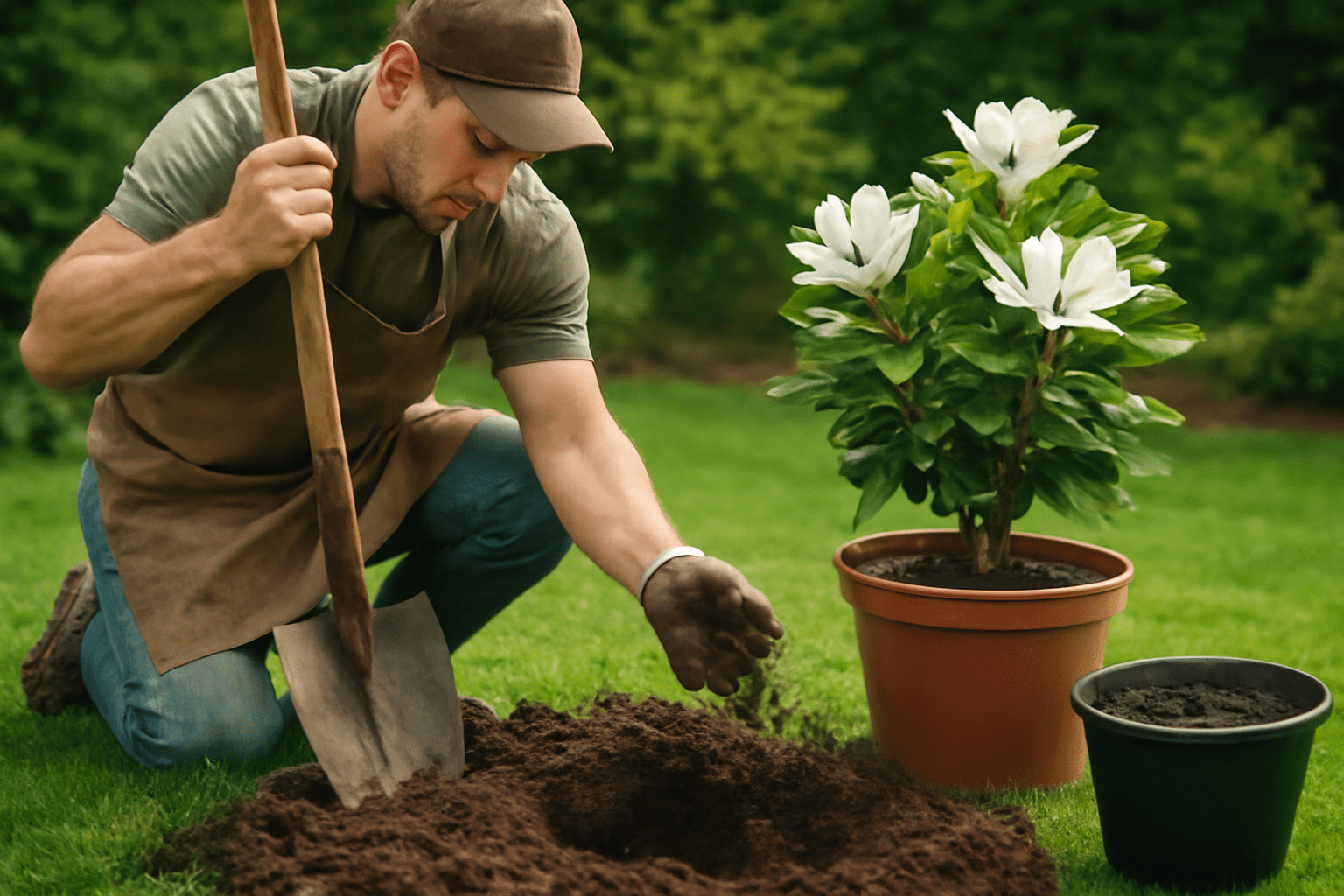
1. 🌞 Choose the Right Location 🌞
Your teddy bear magnolia tree thrives in full sun but can also tolerate partial shade. 🌞 Aim for a spot that gets at least 6 hours of sunlight per day. Avoid low-lying areas where water might collect, as this can cause root rot. 🌧️
2. 🧑🌾 Prepare the Soil 🧑🌾
The key to a healthy tree is well-draining, slightly acidic soil (pH 5.5-6.5). 🌿 Here’s how to get it right:
- Loosen the soil: Use a shovel or garden fork to break up compacted soil. 🌱
- Mix in compost: Add organic compost to improve drainage and provide nutrients. 🌻
- Test soil pH: If you’re unsure of your soil’s acidity, use a simple soil test kit. If it’s too alkaline, mix in some sulfur to lower the pH. 🌾
3. 🕳️ Dig the Right-Sized Hole 🕳️
The hole should be twice as wide as the root ball but only as deep as the tree’s root system. 🌍 Digging too deep can cause the tree to settle too low in the ground, leading to poor root development. 🚫
4. 🌳 Plant the Tree 🌳
- Place the tree: Gently remove the teddy bear magnolia from its pot, being careful not to disturb the roots. 🪴
- Position the tree: Place it in the hole so that the top of the root ball is level with the surrounding soil. This prevents water from pooling around the trunk, which can cause rot. 🌳
- Fill the hole: Backfill with the same soil you dug out, making sure there are no air pockets around the roots. 🌍
5. 💧 Water Thoroughly 💧
After planting, give your teddy bear magnolia tree a deep watering to settle the soil around the roots. 💦 Keep the soil moist but not soggy as the tree establishes itself. Water regularly during the first growing season, especially in dry weather. 🌞
6. 🌾 Mulch for Moisture and Protection 🌾
Spread a 2-3 inch layer of organic mulch (like wood chips or pine bark) around the base of the tree, but leave a small gap around the trunk. 🌿 Mulch helps retain moisture, keeps weeds away, and regulates the soil temperature. 🌸
🌟 Pro Tip for Success 🌟
To give your teddy bear magnolia tree the best start, consider planting it in early spring or fall. These seasons give the tree time to establish roots before the hot summer or freezing winter weather. 🌸❄️
Now you’re all set to plant your teddy bear magnolia tree! 🌿 By following these simple steps, you’ll be well on your way to enjoying its stunning blooms and lush growth in no time. 🌱🌷
😊🌿 Ongoing Care for Your Teddy Bear Magnolia Tree 🌿😊
Once your teddy bear magnolia tree is planted and settled in, ongoing care is essential to ensure it grows beautifully and stays healthy year after year. 🌿 With the right attention, your magnolia will reward you with stunning blooms and vibrant foliage. Here’s how to keep your tree thriving:
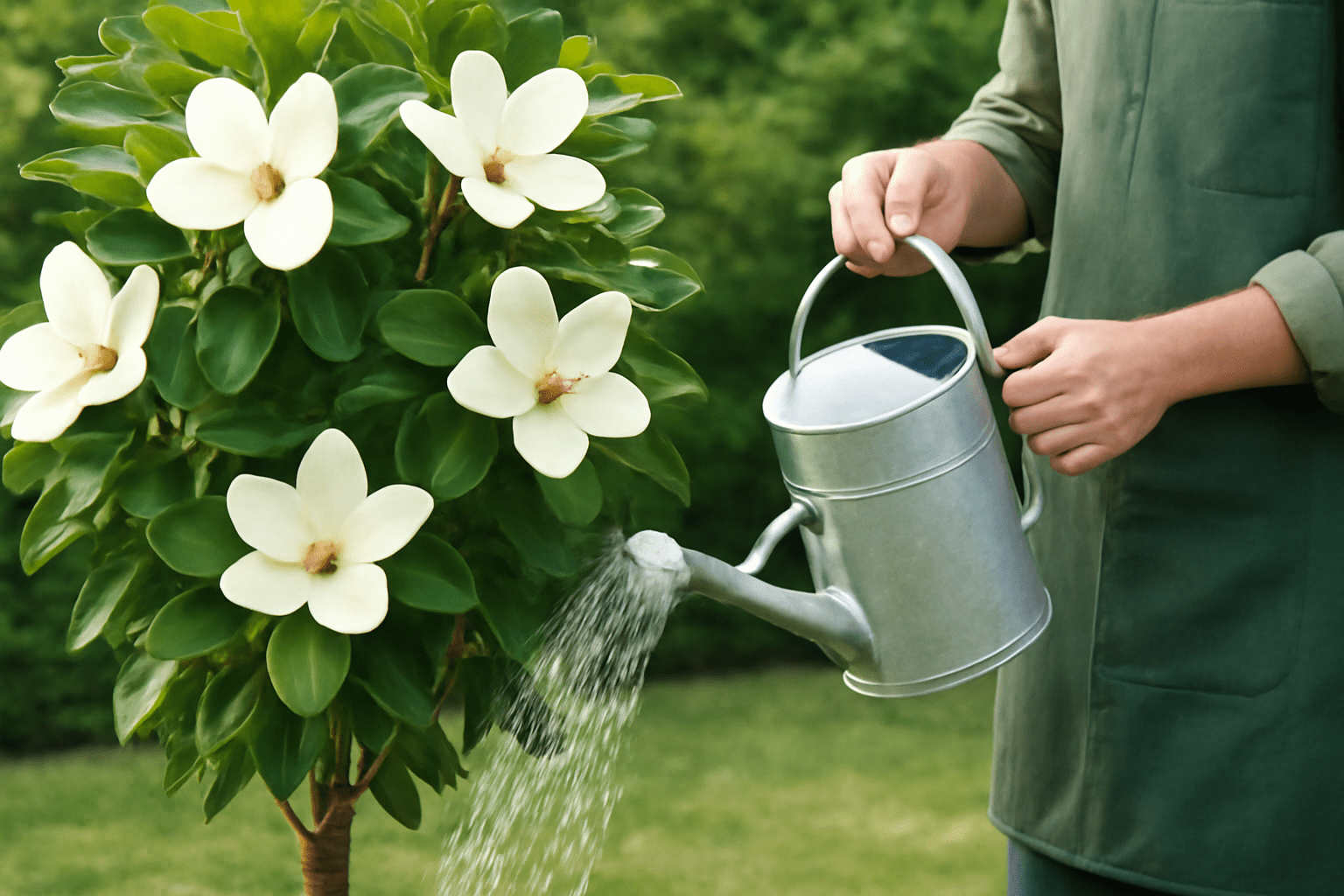
💧 Watering: Keep it Consistently Moist 💧
The teddy bear magnolia tree prefers soil that is consistently moist, especially during its first few years of growth. 🌱 Here’s how to water it properly:
- Deep Watering: Water deeply at the base of the tree, making sure the water reaches the root zone. 💦
- Frequency: During dry spells, water every 7–10 days. In rainy weather, reduce watering. 🌧️
- Avoid Waterlogging: Ensure the soil is well-draining to prevent root rot. You want the soil moist, but not soggy! 🌊
🌸 Fertilizing: Boost Growth and Blooms 🌸
Fertilizing helps your teddy bear magnolia tree stay healthy and produce those beautiful flowers every spring. 🌷 Follow these steps for the best results:
- When to Fertilize: Apply a balanced, slow-release fertilizer in early spring (before new growth appears) and again in late summer. 🌿
- How to Fertilize: Use a granular fertilizer and spread it evenly around the base of the tree, but not directly on the trunk. Water well after applying. 💧
🌿 Mulching: Protect the Roots 🌿
Mulch is your tree’s best friend. It keeps the soil moist, controls weeds, and stabilizes the temperature around the roots. 🌱
- How Much to Apply: Spread a 2-3 inch layer of mulch around the base of the tree, ensuring it doesn’t touch the trunk. 🍂
- What to Use: Organic mulch like wood chips, pine bark, or shredded leaves works best. 🌳
- Tip: Replenish the mulch annually to maintain its effectiveness. 🌿
✂️ Pruning: Maintain Shape and Health ✂️
Pruning helps your teddy bear magnolia tree stay neat and encourages stronger growth. 🌱 Here’s the best way to prune it:
- When to Prune: Always prune after blooming in the spring, as this avoids cutting off any flower buds for next year. 🌸
- What to Prune: Remove any dead, diseased, or damaged branches. You can also trim the tree to maintain its shape, but avoid heavy pruning. ✂️
- How to Prune: Use clean, sharp pruning shears to make clean cuts and avoid damaging the tree. ✂️
🌞 Sunlight: The Right Amount for Perfect Blooms 🌞
The teddy bear magnolia tree thrives in full sun to partial shade. 🌞 Ensure it receives at least 6 hours of direct sunlight daily for the best blooms. 🌼 Too much shade may result in fewer flowers, so keep an eye on its location and make adjustments if needed. 🌿
🦋 Pest and Disease Control: Keep It Healthy 🦋
While teddy bear magnolia trees are relatively resistant to pests, it’s important to watch for common issues:
- Common Pests: Aphids, scale insects, and spider mites may appear. Treat them with insecticidal soap or neem oil. 🐞
- Diseases: Root rot can occur with overwatering, while powdery mildew might show up in humid conditions. Ensure your tree has good airflow and well-draining soil. 🌿
- Tip: Regularly inspect your tree for signs of pests or disease, and address any problems early. 👀
By following these ongoing care tips, your teddy bear magnolia tree will continue to grow strong and produce beautiful blooms for years to come. With just a little attention and care, you’ll enjoy its stunning beauty season after season. 🌸💖
🐻🌼 Common Problems and How to Fix Them 🌸🐻
Growing a teddy bear magnolia tree can be a rewarding experience, but like all plants, it may face a few challenges along the way. Don’t worry – many common problems are easy to fix with a little know-how. Let’s tackle some of the most frequent issues you might encounter and how to solve them. 😊
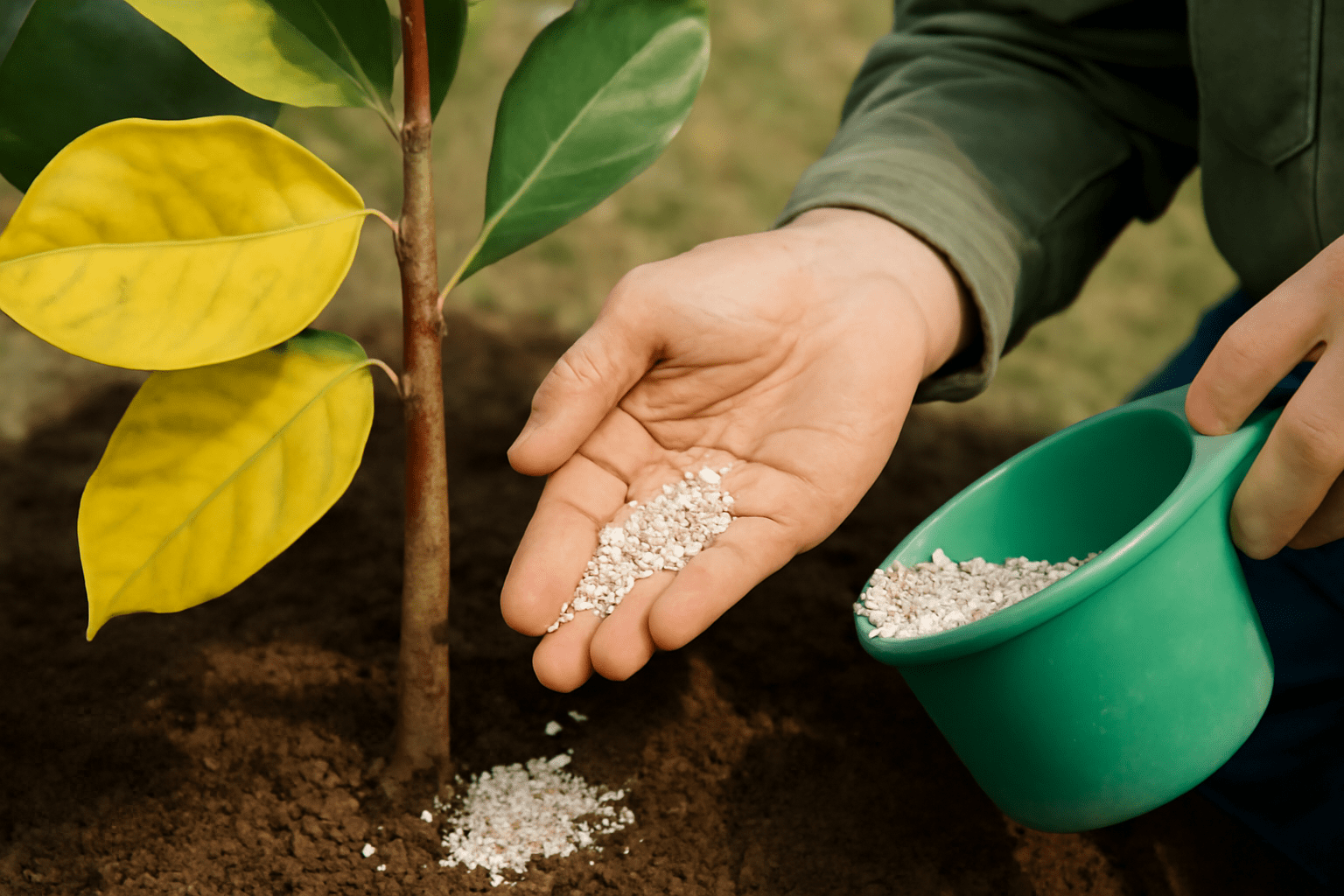
🌿 1. Yellowing Leaves 🍂
Cause: Nutrient deficiencies or poor drainage can lead to yellowing leaves. If your tree isn’t getting enough iron or nitrogen, it may show signs of chlorosis (yellowing of the leaves).
Solution:
- Check the soil: Make sure your teddy bear magnolia tree is in well-draining, acidic soil. Test the pH to ensure it falls between 5.5 and 6.5. 🌱
- Fertilize: Use a balanced fertilizer, or one with micronutrients like iron, to boost the nutrients the tree needs. 🌿
- Amend the soil: Add organic compost to improve drainage and enrich the soil. 🌸
Tip: If the soil is compacted, gently aerate it around the tree’s roots to improve water flow. 🌻
🌸 2. Poor Blooms or No Blooms 🌸
Cause: There are a few reasons why your teddy bear magnolia tree might not be flowering:
- Lack of sunlight 🌞
- Over-pruning ✂️
- Incorrect planting depth 🚜
Solution:
- Sunlight: Ensure the tree is getting at least 6 hours of full sunlight daily. Lack of sun is the most common cause of poor blooming. 🌞
- Avoid excessive pruning: Prune only after blooming to avoid cutting off flower buds. 🌼
- Check planting depth: Make sure the root ball is level with the surrounding soil. Planting too deep can hinder flowering. 🌿
Tip: If your tree isn’t blooming, consider relocating it to a sunnier spot! 🌟
🌿 3. Root Rot 🦠
Cause: Overwatering and poor drainage are the main culprits for root rot, which can quickly damage your teddy bear magnolia tree.
Solution:
- Water properly: Water deeply but infrequently. Always let the top 2 inches of soil dry out between waterings. 💧
- Improve drainage: Ensure the soil drains well. If it doesn’t, amend it with sand or organic matter. 🌿
- Check the roots: If you notice any signs of root rot (like a foul smell or mushy roots), trim off the affected areas and repot the tree in fresh, well-draining soil. 🌱
Tip: When watering, always check that the water isn’t pooling around the tree’s base. 💦
🌱 4. Wilting or Drooping Leaves 😟
Cause: Wilting leaves can be a sign of dehydration or root damage. It can also be caused by too much direct sunlight, especially in very hot climates.
Solution:
- Water consistently: Ensure your tree is receiving enough water, especially during dry spells. Make sure the soil is moist but not waterlogged. 💧
- Mulch around the base: Mulching helps retain moisture and keeps the roots cool in hot weather. 🌞
- Check for pests: Sometimes, pests like aphids or scale insects can stress the tree, causing wilting. If you notice insects, treat with an organic insecticide. 🐜
Tip: A good rule of thumb is to water deeply once a week, rather than shallow watering every day. 💧
🌸 5. Pests and Diseases 🐜
Cause: Like many trees, the teddy bear magnolia tree can attract pests such as aphids, scale insects, or even fungal diseases.
Solution:
- Pest control: Use natural remedies like neem oil or insecticidal soap to get rid of pests without harming the tree. 🌿
- Disease management: If you notice mold or fungal spots, prune away affected branches and ensure good air circulation around the tree. 🍂
- Prevention: Regularly inspect your tree for any early signs of pest damage or disease, especially during spring and summer. 🌸
Tip: Keep fallen leaves and debris cleared away from the base of the tree to reduce the chance of fungal growth. 🌿
With just a little attention and care, your teddy bear magnolia tree can thrive and become a beautiful centerpiece in your garden. 🌸 Keep an eye out for these common issues, and use the solutions provided to get your tree back on track. Gardening doesn’t have to be hard – with these tips, you’ll enjoy a healthy, vibrant tree that blooms year after year. 🌳✨
🌱 Seasonal Care for Your Teddy Bear Magnolia Tree 🌸
Taking care of your teddy bear magnolia tree through the changing seasons is key to keeping it healthy, vibrant, and blooming beautifully year after year. Here’s a simple breakdown of how to care for your tree throughout the year—ensuring it thrives in all weather conditions. 🌞❄️
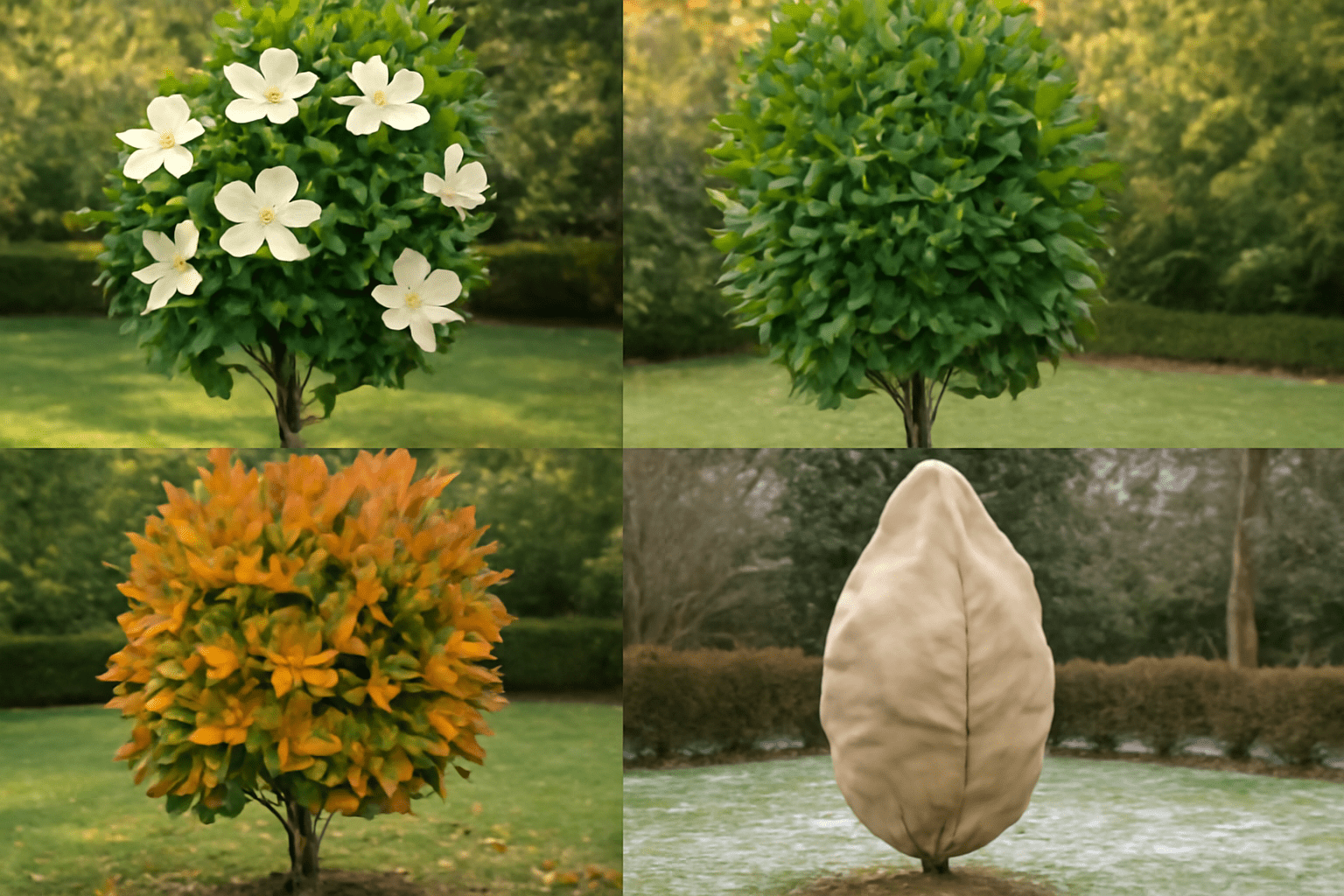
🌷 Spring: Kickstart the Growth Season 🌷
Spring is the time when your teddy bear magnolia tree comes to life. This is the season when you’ll see those gorgeous blooms start to unfold. 🌼
- Prune after blooming: Trim any dead or damaged branches to encourage fresh growth. Avoid heavy pruning before the tree blooms to protect the flower buds. ✂️
- Fertilize: Use a balanced fertilizer to give your tree the nutrients it needs for healthy growth. Apply it early in the season, before the first blooms appear. 🌿
- Mulch: Add a fresh layer of mulch around the base to retain moisture and protect the roots as temperatures rise. 🌾
💡 Tip: Pruning after blooming ensures you don’t accidentally cut off flower buds. 🌸
☀️ Summer: Keep It Cool and Hydrated 💧
During summer, your teddy bear magnolia tree will need a little extra TLC to cope with the heat and dryness. ☀️
- Water deeply and regularly: While magnolias are fairly drought-tolerant once established, they still need consistent moisture. Water deeply to ensure the roots stay hydrated, especially during dry spells. 💦
- Mulch again: Add a new layer of mulch to help keep the soil cool and reduce evaporation. 🌱
- Monitor for pests: Keep an eye out for any pests or diseases, especially aphids or fungal infections, which can harm the tree in humid weather. 🐜
💡 Tip: Water your tree in the early morning or late evening to avoid evaporation and stress from the midday heat. 🌅
🍁 Fall: Prepare for Cooler Weather 🍁
Fall is a critical time for your teddy bear magnolia tree to prepare for the colder months ahead. 🍂
- Deep watering: Before the first frost, water your tree deeply to help it survive the winter months. This ensures the soil stays moist and the roots are well-hydrated. 🌧️
- Prune sparingly: After blooming has finished, do any necessary pruning to shape the tree and remove dead or damaged branches. ✂️
- Add mulch: Mulch once again to insulate the roots and protect them from sudden temperature drops. ❄️
💡 Tip: Watering deeply before winter ensures the tree’s roots stay hydrated when it’s too cold to absorb moisture. 🌾
❄️ Winter: Protect and Preserve 🧣
Winter can be harsh, but with proper care, your teddy bear magnolia tree will make it through the cold months. 🧤
- Protect from extreme cold: If you live in a region with freezing temperatures, wrap your tree in burlap or provide a tree cover to shield it from the wind and frost. 🧥
- Avoid heavy pruning: Don’t prune during the winter months—leave this for early spring once the tree starts to wake up. 🌱
- Check for damage: Regularly inspect your tree for any damage caused by winter weather, such as broken limbs from heavy snow. 🌨️
💡 Tip: Protecting your magnolia from extreme cold in the winter helps prevent unnecessary stress and damage. 🌬️
By following these seasonal care tips, your teddy bear magnolia tree will flourish throughout the year, bringing beauty and joy to your garden with minimal effort. 😊 Keep an eye on the needs of your tree with each changing season, and you’ll enjoy healthy growth and stunning blooms for many years to come. 🌿🌼
🌟 Quick Reference Care Chart 🌟
Here’s a handy, at-a-glance care chart for your teddy bear magnolia tree, designed to make maintenance easy and stress-free! 🌸
| Care Task | Spring | Summer | Fall | Winter |
| Watering | Deep water after planting 🌱 | Water deeply and regularly 💧 | Deep watering before frost ❄️ | Water only if necessary (minimal) 💦 |
| Fertilizing | Apply balanced fertilizer 🌿 | |||
| Pruning | After blooming, shape the tree ✂️ | Prune sparingly after blooming ✂️ | Avoid heavy pruning ❌ | |
| Mulching | Add mulch to retain moisture 🌾 | Add mulch to cool the soil 🌱 | Add mulch to insulate roots 🌍 | Add protective mulch if needed 🌾 |
| Pest & Disease Control | Monitor for early pests 🐜 | Monitor for pests and diseases 🦠 | Check for winter damage ❄️ | |
| Cold Protection | Protect from extreme cold 🧣 |
💡 Tip: Keep this chart handy and refer to it throughout the year to stay on top of your teddy bear magnolia tree’s care needs! 🌿
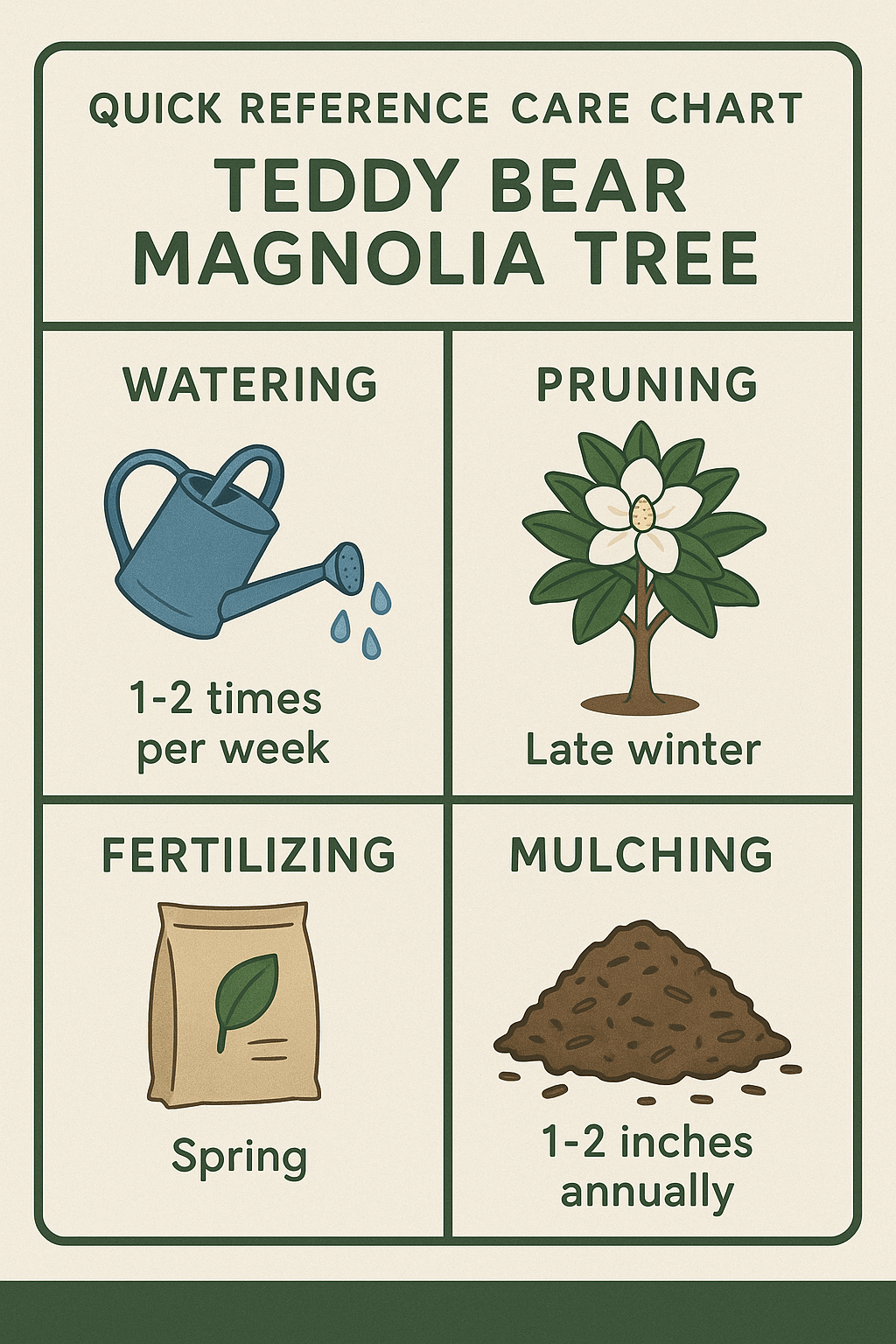
With this simple reference guide, you can ensure your tree gets the right care all year round. 🌱🌸
🌸 Final Thoughts: Enjoying the Beauty of Your Teddy Bear Magnolia Tree 🌸
Growing and caring for a teddy bear magnolia tree doesn’t have to be a challenge! By following the expert tips shared in this guide, you’re well on your way to creating a beautiful, thriving tree that will be the highlight of your garden. 🌿 From selecting the right planting spot to ensuring seasonal care, each step will bring you closer to experiencing the stunning blooms and lush greenery of your magnolia. 🌷
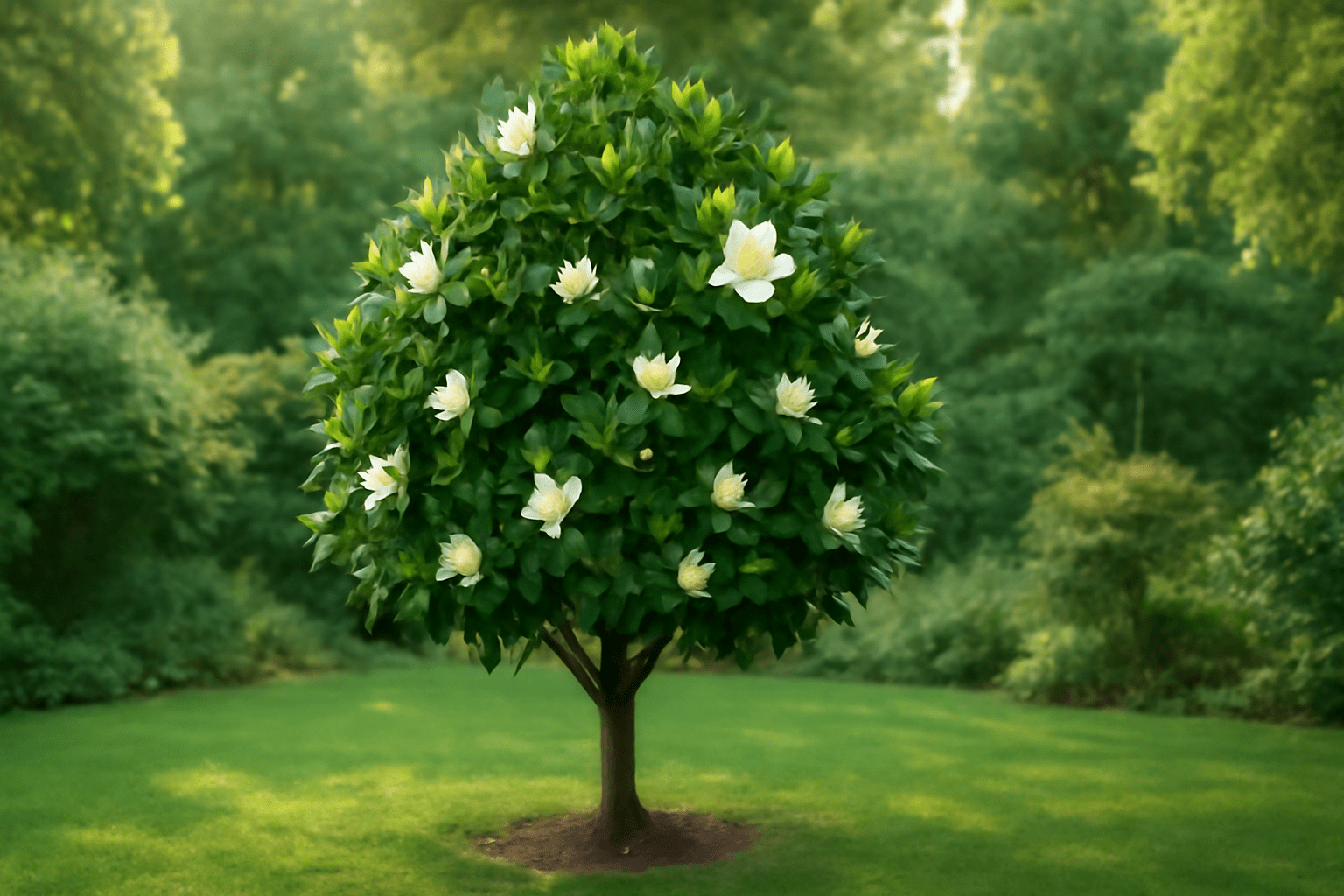
Remember, consistency is key. Whether it’s watering during dry spells, pruning after blooms, or protecting your tree during the winter months, taking a few simple steps each season will keep your magnolia looking its best. 🌱
So, go ahead and start planting your teddy bear magnolia tree today! With a little patience and care, you’ll be rewarded with a garden centerpiece that adds elegance, beauty, and a touch of nature’s wonder to your home. 🌳💚
Happy gardening! 🌸✨
Frequently Asked Questions (FAQs)
How fast does a Teddy Bear Magnolia tree grow?
A Teddy Bear Magnolia tree grows at a moderate rate, typically 1 to 2 feet per year. With proper care, it can reach its mature height of 10 to 15 feet in about 5 to 7 years.
Can I grow a Teddy Bear Magnolia tree in a pot?
Yes, a Teddy Bear Magnolia tree can be grown in a pot, especially if you have limited space. Choose a large container with good drainage, and make sure to provide it with enough sunlight and regular watering.
Why isn’t my Teddy Bear Magnolia tree blooming?
If your Teddy Bear Magnolia tree isn’t blooming, it could be due to a few reasons: insufficient sunlight, improper pruning, or nutrient deficiencies. Ensure the tree receives at least 6 hours of sunlight daily and prune it after it blooms to avoid cutting off flower buds.
How often should I water my Teddy Bear Magnolia tree?
Water your Teddy Bear Magnolia tree deeply once a week, especially during dry spells. During the first year of planting, ensure it stays well-watered until the tree becomes established. Avoid overwatering, as this can lead to root rot.
What type of soil is best for a Teddy Bear Magnolia tree?
The Teddy Bear Magnolia tree prefers well-draining, acidic soil with a pH of 5.5 to 6.5. If your soil is too alkaline, amend it with organic compost or peat moss to adjust the pH and improve drainage.
How do I protect my Teddy Bear Magnolia tree in winter?
In winter, protect your Teddy Bear Magnolia tree by covering it with burlap or using tree wrap to shield it from cold winds and frost. Mulching around the base can also help insulate the roots from extreme cold.
When is the best time to prune a Teddy Bear Magnolia tree?
The best time to prune your Teddy Bear Magnolia tree is right after it finishes blooming in the spring. This helps avoid cutting off any potential flower buds while keeping the tree healthy and well-shaped.
Can I plant a Teddy Bear Magnolia tree in a shady area?
While the Teddy Bear Magnolia tree can tolerate partial shade, it thrives best in full sun. For optimal growth and blooming, choose a location that receives at least 6 hours of direct sunlight each day.
